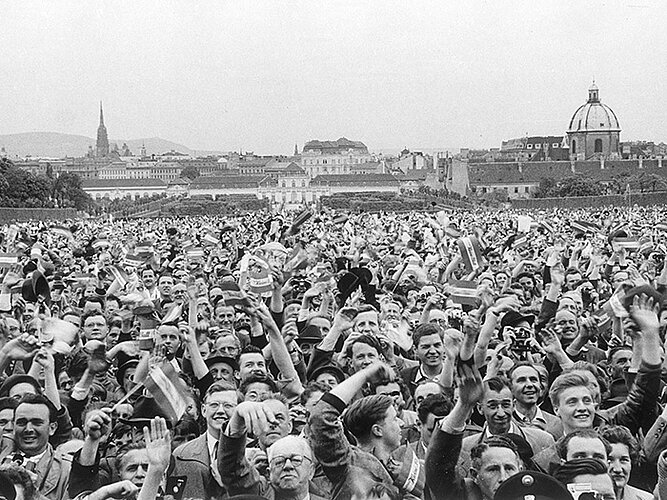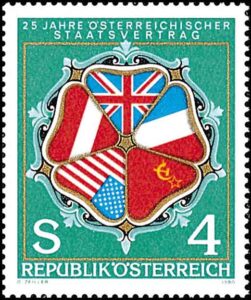The Austria Option for Ukraine
EDITORIAL, 26 May 2025
#901 | Marilyn Langlois – TRANSCEND Media Service
On 15 May 1955, the Austrian State Treaty was signed, signaling Austria’s latest metamorphosis into a sovereign, democratic republic, neutral in perpetuity, with its former occupiers guaranteeing the security of its borders. Could a similar destiny be in store for Ukraine?
24 May 2025 – Seventy years ago, the Austrian State Treaty (Staatsvertrag betreffend eines unabhängigen und demokratischen Österreich) was signed to widespread acclaim in Vienna’s Belvedere Palace by foreign ministers of Austria and the four powers that had occupied it since the end of World War II. The Soviet Union, the United Kingdom, the United States, and France thereupon agreed to withdraw their forces and let Austria be free, signaling its latest metamorphosis into a sovereign, democratic republic, neutral in perpetuity, with its former occupiers guaranteeing the security of its borders.
Could a similar destiny be in store for Ukraine, and wouldn’t it be an auspicious outcome for all those affected by unrelenting bursts of violence in the region over the last 11 years?
May 15 of this year is the date Russian President Putin proposed for resuming the peace talks between Russia and Ukraine that had been nearly completed in April, 2022, but were abruptly abandoned by Ukraine at the urging of UK’s then Prime Minister Johnson. A fully accredited Russian negotiating team duly appeared in Istanbul on the appointed date, and after much kicking and screaming by President Zelensky, a reluctant Ukrainian team finally sat down with them the following day, May 16.
It’s important to acknowledge that the broader geopolitical conflict is actually between Russia and US-led NATO, which seeks to weaken Russia and gain dominance over Eurasia’s vast natural resources. A series of NATO provocations in Ukraine provided the casus belli for the current crisis, causing Ukraine to bear the brunt of casualties and destruction. NATO’s unwarranted eastward expansion, the US-sponsored Maidan coup d’état, NATO’s disregard of the 2014 and 2015 Minsk peace accords, NATO’s acquiescence and covert support for Ukraine’s violent repression of its ethnic Russian population in the Eastern Oblasts, and continual NATO military threats right on Russia’s border finally induced Putin to say enough is enough.
Shortly after Russia invaded Ukraine in late February, 2022, in defense of secessionist Donetsk and Lugansk in the east, it withdrew from central Ukraine once the above-mentioned peace agreement was negotiated in Istanbul. The UK and US urged Zelensky not to sign it, however, promising to give him all the weapons he’d need to defeat Russia on the battlefield.
The US has been an overt ally of Ukraine in its conflict with Russia, supplying one side with abundant weaponry, financial support, intelligence reports and tactical advice, while imposing severe economic sanctions and freezing significant assets of the other side. So why did US President Trump recently defy the wishes of Ukraine’s president and leaders of the UK, France and Germany by insisting the peace talks go forward? In the absence of any evidence that the US has “switched sides” or could by any stretch of the imagination be considered an unbiased mediator, a more reasonable guess is that key figures in US leadership are finally coming to grips with the fact that Ukraine is on an inexorable path to defeat despite massive Western and Ukrainian propaganda to the contrary.
Russia’s military has been successful in defending disputed regions home predominantly to Russian speakers and also expelling Ukrainian military incursions into undisputed areas of Russia. Furthermore, the “bone crushing” sanctions imposed on Russia by NATO have backfired, as Russia’s economy and relations with other nations flourish. Hence the US push for peace talks aims, perhaps, to eke out the best realistically possible outcome at this juncture.
It remains to be seen whether these talks will continue and eventually bear fruit, considering not only the deep chasm between the official positions of Ukraine and Russia, but also the fact that Ukraine’s Western sponsors, upon whom it is dependent for survival, can’t agree among themselves about the best path forward. The alternative, however, is bleak (except for the profiteering arms industry!): Continued fighting and killing of soldiers on both sides and potential Russian advances much further into Ukraine to establish a buffer zone.
What could a solution look like? Here’s a rough outline of an Austria Option that could meet legitimate needs of all parties:
- Recognition by Ukraine and NATO of Crimea, Donetsk, Lugansk, Kherson and Zaporizhzhia as part of Russia (as affirmed by local residents via multiple referenda)
- Withdrawal of all Ukrainian and NATO military personnel from those regions
- Withdrawal of all Russian military personnel from all remaining areas of Ukraine
- Withdrawal of NATO military personnel (including advisors) and cessation of any form of military aid to Ukraine
- Assurance of Ukraine’s neutrality and exclusion from NATO in perpetuity
- Russia and NATO to guarantee the security of Ukraine’s borders
- Assurance of full and equal rights of all Russian speakers in Ukraine and all Ukrainian speakers in Russia
- Commitment by Ukraine to democratic governance, including lifting its ban on opposition political parties, eliminating its Miretvorets “kill list” targeting dissidents, and ending impunity for violence perpetrated by neo-Nazi Banderist elements
- Lifting NATO sanctions on Russia
- Commitment by all parties to creating a robust security architecture for all of Europe and Eurasia, focusing on constructive relationships and trust building, moving away from military alliances.
- Encouraging fair trade of goods and natural resources among all parties
- Encouraging positive social and cultural exchanges among all parties
To those who might question the first point on the above list, let’s look a bit deeper into Austria’s history. In its heyday under the Habsburgs, Austria comprised a vast empire that spread eastward from its current borders to include much of central and eastern Europe (including parts of what is now Ukraine!).
Following its defeat in World War I it disintegrated, with much of its erstwhile population (including Czechs, Slovaks, Hungarians, Poles, and Yugoslavs) rejecting domination by German speaking Vienna and asserting their right to self-determination. The small rump state of Austria shrank to a tiny fraction of its former size. German speaking South Tirol was separated from Austria and incorporated into Italy, a move resented by locals at the time, but eventually morphing into a thriving bilingual province.
Russia’s boundaries have also varied appreciably in the past. When the Soviet Union broke up, Moscow did not insist on retaining power over the former Soviet Socialist Republics that surrounded Russia, agreeing to their independence and maintaining constructive relationships with most of them. Borders do change, ideally though not always with input from those most affected, namely the local residents.
Between the two world wars, Austria was still struggling to re-define itself as an emerging republic when Hitler’s Germany annexed it from 1938-1945, followed by ten years of military occupation by the four allies. When Austria finally regained full independence and sovereignty in 1955, no one complained about Hungary or Czechoslovakia no longer being part of it. The biggest crisis Austria faced along its borders since then was a nagging dispute between German and Slovenian speaking communities in the southeast about the official language for local road signs.
During negotiations leading up to Austria’s State Treaty, some Westerners were leery of allowing the bulk of Austria to be surrounded by the Iron Curtain. As we now know, duplicitous NATO wasn’t about to take any chances. In the 1990’s Operation Gladio came to light, under which NATO had positioned secret armies with hidden weapons caches throughout Western Europe during the Cold War, ready to help fend off any potential Soviet incursion (that never happened), including in the four neutral countries of Sweden, Finland, Switzerland and Austria, as historian Daniele Ganser has extensively documented[i]. Neither the Soviet Union nor any Warsaw Pact states ever posed a threat to Austria, which has consistently leaned towards the West, even joining the EU, while maintaining official neutrality.
Little Austria has done pretty well since 1955. Of course, it’s not perfect and has its issues (for example, joining Germany in supporting the apartheid and genocidal state of Israel, conflating a duty to atone for its Nazi past with giving Israel a free pass on committing similar atrocities). On overall quality of life measures, it’s right up there, as I experienced myself while living in Vienna some decades ago. Austria has less homelessness, less violent crime and less extreme wealth inequality than my native US. It lives in peace with its neighbors, offering its rich cultural heritage and beautiful natural landscapes to locals and visitors alike.
The seeds of the Austrian State Treaty, foreseen as part of Nazi Germany’s capitulation package, were planted at the 1943 Moscow Conference by the Soviet Union, UK and US, when the Third Reich’s defeat appeared inevitable. While Germany ended up divided between NATO and the Warsaw Pact—later reuniting fully into NATO and remaining under US military occupation to this day–Austria held out for independence and neutrality.
Just as Hitler overreached and lost, NATO has overreached with its Ukraine project and is losing.
It took 12 years for Austria’s freedom to come to fruition. Let’s urge the parties involved to free Ukraine in less time than that. After all, Russia and Ukraine have the advantage of shared cultural and historical traditions. Many from each language group have relatives in the other.
To Ukrainians: rather than continue to sacrifice your young (and older) men as soldiers to NATO’s lost cause while the real aggressors watch from the comfort of their posh digs in London, Paris, Berlin and Washington, isn’t it time to reject NATO’s machinations and turn the hate that is being fomented into brotherly love? May peace prevail and the healing begin….
See also:
- Willing Suspension of Disbelief: The Danger of Overlooking US Ties to Nazism, 30 May 2022
- Will the Circle be Unbroken? Reviving the Spirit of Bandung and Panchsheel, 13 March, 2023
NOTE:
[i] Ganser, Daniele, NATO’s Secret Armies: Operation Gladio and Terrorism in Western Europe, Routledge, London and New York, 2005 (English Ttanslation).
Ganser, Daniele, NATO Geheimarmeen in Europa: Inszenierter Terror und Verdeckted Kriegsführung, Orell Füssli Verlag, Zürich, 2005 (German original).
Austria was spared Gladio’s many nefarious covert actions, which included perpetrating terrorist bombings in Italy and Belgium and blaming them on radical leftists, kidnapping and murdering Italian premier Aldo Moro who had the temerity to encourage collaboration between his conservative Christian party and the communists, and fixing elections in multiple countries when local communist parties achieved popularity.
____________________________________________
 Marilyn Langlois is a member of TRANSCEND USA West Coast. She is a volunteer community organizer and international solidarity activist based in Richmond, California. A co-founder of the Richmond Progressive Alliance, member of Haiti Action Committee and Board member of the International Center for 9/11 Justice, she is retired from previous employment as a teacher, secretary, administrator, mediator and community advocate.
Marilyn Langlois is a member of TRANSCEND USA West Coast. She is a volunteer community organizer and international solidarity activist based in Richmond, California. A co-founder of the Richmond Progressive Alliance, member of Haiti Action Committee and Board member of the International Center for 9/11 Justice, she is retired from previous employment as a teacher, secretary, administrator, mediator and community advocate.
Tags: Austria, Austrian State Treaty, Conflict Mediation, Conflict Transformation, Europe, Germany, Ukraine
This article originally appeared on Transcend Media Service (TMS) on 26 May 2025.
Anticopyright: Editorials and articles originated on TMS may be freely reprinted, disseminated, translated and used as background material, provided an acknowledgement and link to the source, TMS: The Austria Option for Ukraine, is included. Thank you.
If you enjoyed this article, please donate to TMS to join the growing list of TMS Supporters.

This work is licensed under a CC BY-NC 4.0 License.
3 Responses to “The Austria Option for Ukraine”
Join the discussion!
We welcome debate and dissent, but personal — ad hominem — attacks (on authors, other users or any individual), abuse and defamatory language will not be tolerated. Nor will we tolerate attempts to deliberately disrupt discussions. We aim to maintain an inviting space to focus on intelligent interactions and debates.


I agree that NATO has at least opportunity for Russia to conclude it wants to expand its influence around Russia. I myself would prefer my country not to be member of NATO. But I don’t have indications that any country ()like Poland has been forced to join NATO.
Seeing the fate of Ukraine I can fully understand that countries like Finland and Sweden choose to join the Article 5 club. And I do welcome Ukraine to join the EU and to not join NATO.
I wonder if the author has been able to visit the occupied Ukrainian regions as supervisor to be able to point out ‘(as affirmed by local residents via multiple referenda)’?
Should the rough outline not as well mention:
– Commitment by Russia to democratic governance, including lifting its ban on opposition political parties, elimination targeting dissidents (like Navalny and even Prigozjin), and ending impunity for violence perpetrated by KGB elements?
Does the series of NATO provocations in Ukraine justify an incursion in which the half million lives already have been taken from the peoples of Russia and Ukraine?
Dear Leo Maathuis, Thank you for your thoughtful comments. Some responses:
You’re right no one forced Poland or any other country to join NATO. On the other hand, NATO itself, which is dominated by the US, made a solemn pledge in 1991 not to expand eastward. In other words, even if eastern European countries wanted to join NATO, their membership should not have been allowed by NATO.
As you say, the people of Sweden and Finland are free to apply to join NATO, but they should also keep in mind the requirement to now spend 2-5% (depending on potential rule changes) of their GDP on military, and also to send their own soldiers into any wars involving other NATO members, along with the close to zero realistic risk of Russia having any interest at all in invading them. Plus, NATO itself should never have approved their membership, as with all of the eastern European countries.
I myself have not visited the disputed areas in Donbas, but independent journalist Eva Bartlett has done on the ground reporting there numerous times in the past 6 years. She was there and reported on the referenda processes in Donetsk, Lugansk, Kherson and Zaporizhzhia in the fall of 2022, observing almost no opposition to becoming part of Russia. Independent journalist Patrick Lancaster was also there as an observer and came to the same conclusions. Former UN weapons inspector Scott Ritter visited Lugansk, Donetsk and Crimea in January 2024 and observed no dissatisfaction among locals with being part of Russia.
Regarding your suggestion to include a commitment by Russia to democratic governance, allowing opposition political parties, and following due process when dealing with alleged criminal activity, I wager Russia would agree to that and assert these are already in place, in the absence of evidence of widespread and systematic violations. Russia does have regular elections, Communist Party being the largest opposition party among others. Navalny, whose party has only a very small following, was convicted of crimes in Russia, and his alleged persecution was played up in Western propaganda. Detailed evidence about all of this should certainly be openly laid out by all sides.
And lastly, the Russian incursion of February 2022 can also be seen as a last ditch attempt to get Ukraine to the negotiating table, which it did, and the whole affair could have ended by early April, 2022 with the Istanbul agreement, had not NATO intervened to stoke the flames of continued warfare. And now we see Ukraine (surely with NATO knowledge and approval) intensifying its direct attacks deep into Russia. All of this could have been avoided, and should be stopped now on reasonable terms.
Thank-you Marilyn for this elegant solution proposal to a terrible situation. I hope that this reaches the hearts and minds of those who could make it a reality.